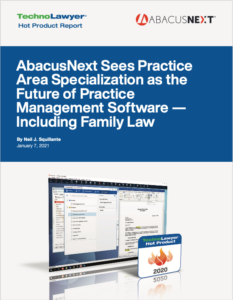
Leveraging Legal Video Conferencing Tools in Family Law Firms
In our new virtual world, the pandemic has been especially tough on family law practices. True, attorneys that navigate divorce, elder abuse, custody battles and other domestic issues have always handled cases where emotions run high. But the changes of 2020 have exacerbated it. Consider families where a relative dying of COVID-19 has shifted guardianship of a young child; a marriage has changed during lockdown and is now headed into divorce; an international adoption is delayed, or a custody arrangement has been altered. Many family law attorneys are dealing with high demand and stressed clients right when their clientele can’t or won’t visit their office.
It’s not just attorneys who are feeling the strain. Some state and local family courts have closed or reduced their activity on the docket, trying to shift oral arguments, arraignments, sentencing and other procedures to virtual courtrooms. In the same vein, many family law firms are moving toward virtual practice management – and they’re finding that legal software equipped with legal video conferencing is essential to running a successful remote practice.
Wondering how to start digitizing your law firm and what technology you need to become more efficient? Download your free copy of the Modern Law Firm Checklist today.
How legal video conferencing tools are bridging the gap
A major reason that video conferencing has become so vital: the likelihood that every family law practice will see its share of clients with trauma. In 2001, researchers Maxine Harris and Roger Fallot coined the phrase “trauma-informed law” to describe a type of legal practice that strives to serve these clients in a positive manner – not only for clients but the attorneys who advocate for them. By adopting legal video conferencing, lawyers can improve secure and private communication with traumatized clients, win their trust, and clarify the issues at hand to better advocate for their clientele.
Attorneys new to these legal technology tools have discovered, however, that they are far more than just FaceTime for family lawyers. They’ve also realized that Zoom or Skype are insufficient for their needs; those platforms might be fine for a quick chat, but they lack the features, functionality, and security essential to a modern law practice. They also rarely integrate with the tools the law firm uses most.
Instead family law practitioners are turning to legal video conferencing – which offers key advantages in remote work arrangements, virtual client meetings, staff collaboration, and firm productivity.
7 ways family law firms can leverage legal video conferencing tools
Family attorneys new to video conferencing may assume their use is limited to simple meetings. In fact, the benefits extend far beyond. Consider implementing these 7 ways other modern firms leverage their video platforms.
- Go beyond basic staff meetings. While tools like Zoom or Skype are suited for informal chats, legal video conferencing tools are equipped to facilitate all kinds of meetings. Conferences with clients or other counsel, check-ins with police officers, educators, therapists or social workers, coworker collaborations and out-of-town depositions can all be handled through video conferencing.
- Let prospective clients know about your digital capabilities. In our current year of uncertainty, many clients value legal video conferencing because they feel reassured by seeing their new attorney’s face even if they can’t travel to the office. But video conferencing remains an asset even in the best of times because it caters to client convenience. Let clients know they can have secure and candid discussions with their attorneys wherever they are, whenever their schedule allows.
- Use legal video conferencing to cut costs. Video conferencing can make it easier to hire new staff – giving firm partners a good sense of a candidate’s personality without flying them in. It can also minimize staff business travel, eliminating hotel and airfare and rental car costs. Even the reduction of paperwork, emails and phone calls to resolve simple questions can drive higher profit over time through faster case outcomes and more focused productivity.
- Record and archive meetings for future reference. Rather than checking written notes or scheduling additional client meetings with other staff, anyone can view archived meetings to get up to speed, fact-check documents, answer questions and provide invaluable historical documentation.
- Use a solution that benefits staff and clients. Scheduling capabilities should sync with your calendar; features like text chat, file sharing and screen sharing controls and password protection will all make your meetings efficient and safer. Collectively, this kind of functionality can accelerate productivity within your firm and provide a smoother client experience.
- Use legal video conferencing to expedite cases. Do you really need to wait until next week for a meeting just because the client is visiting another state? If your paralegal is out of the office, can you conference her into the meeting so she can hear every detail in the client’s story straight from their mouth? Scheduling delays and calendar conflicts have traditionally slowed cases down, but video meetings can dissolve those barriers and keep business moving forward.
- Support remote work practices. While this is important during the pandemic, virtual workplaces are likely here to stay. Help staff become adept at video collaboration now to prepare for a future where most law firms are remote-friendly. Any busy family law practice will have attorneys and support staff traveling between court and client meetings or working from home on occasion. Legal video conferencing keeps employees connected and collaborative – letting them work together on documents and brainstorm case strategies even from a distance.
Turning video conferencing into client connections
The ultimate benefit of legal video conferencing is the goal of every family law practice: client satisfaction. Whether you’re advocating for an abused child or settling a contentious divorce, a sense of trust and personal connection is critical for the lawyer-client relationship. Clients can read your facial expressions, interpret visual cues, and build rapport with you and your staff as people, rather than simply names on an email or voices on a phone. That connection typically leads to more candid discussions and creative ideas – and stronger outcomes.
In addition to legal video conferencing, using legal practice management software specifically tailored for family law firms can make your professional environment more pleasant and help your staff attain better work-life balance. A single-screen solution means your staff can manage all cases – from divorce to adoption to elder abuse to domestic violence to guardianship – from a single place, so no one duplicates work or has to jump between systems to do research.
 Download the free TechnoLawyer Hot Product Report for an inside look at the top features of the AbacusNext Family Law Suite.
Download the free TechnoLawyer Hot Product Report for an inside look at the top features of the AbacusNext Family Law Suite.
Document automation tools can quickly prepare standardized forms while time tracking and other digital workflows can save hours of manual work; online client portals can reduce the number of phone calls and emails from nervous clients.
Solutions like AbacusNext Family Law Suite and legal practice management software can unlock new efficiencies even when your law firm is still navigating the changes wrought by the COVID-19 pandemic. Let us know your goals for your family law practice and how video conferencing is changing client outcomes for you.